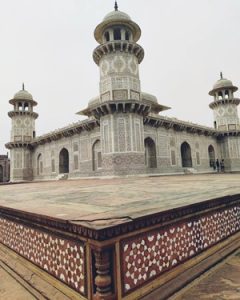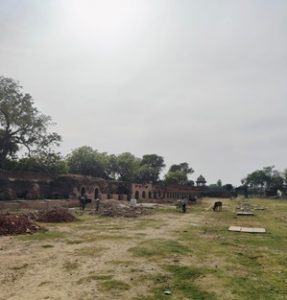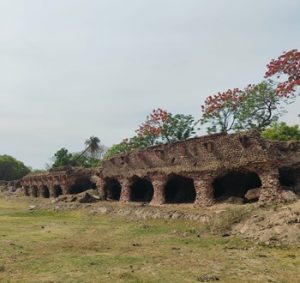My love for Noor Jahan1 started over a decade ago. It is probably why I go the extra mile for her – be it hunting down an obscure tomb “Shahpir ka Dargah” she built for her advisor/physician, in a hidden lane in Meerut or coming back to Agra three times in two and a half years for her.

This time in Agra, I did my second visit to the monument of Itimad-ud-Daula, built under the keen supervision and patronage of Noor Jahan. It is a fine marble structure with inlay work, the first to be built by the Mughals. Called a “miniature jewel box,”it inspired the Taj Mahal. Yet this wasn’t a monument dedicated to romantic love; Noor built this as a homage to her parents who were critical to the making of who she was to become.
The daughter of an aristocrat in Safavid Iran,2 Noor was finely educated in the Sufi traditions of music and poetry and absorbed the Persian literary and cultural conventions. They moved to India and found place in the Mughal Court.

When Noor Jahan married Jehangir in 1611, she was already 34 years old (old by the standard of the time), widowed and had a daughter. She wasn’t a nobody – she was the daughter of the Grand Vizier, Mirza Ghias Beg who was then serving the 42-year-old emperor, Jehangir.3
Jehangir already had 19 wives, but Noor was different. As soon as he married her, he made her his Chief Wife and soon she was the co-sovereign running the Mughal empire in a way no Mughal Empress had ever done before (or after).

There are several historical descriptions of Noor Jahan – a woman of exquisite taste, aesthete, playful and exceedingly charming. Historian Ruby Lal describes her as an embodiment of the Hindustani-Indic culture: a space that allowed different senses of being within an individual and adopt diverse cultural practices.
Yet in the way that Jehangir viewed her is where her multi-dimensional personality comes through. The life-long sway she had over him wasn’t because she gave him a child (they never had children together), or because she was beautiful (though she was). It was as historian Ira Mukhoty concludes in her book, because Jehangir found in her “felicitous blend of comforting, reassuring care and a woman with enormous talent, charisma, and ability. Noor Jahan share(d) Jahangir’s aesthetic sense and contribute(d) in many ways to the expansion of his imperial vision and legacy.” Jehangir regularly wrote of her exceptional intelligence and ability.
Her sway over the Mughal court was also unusual. Unlike any other Mughal Queen, drums were played at Noor’s arrival. She was regularly seen issuing dictates to nobleman from her balcony. Noor also had strong influence on the aesthetic and fashion at court, apart from political astuteness, evidence of which can be seen in the many farmans (directives) that were issued in her name.
II
The second part of my journey in Agra covered yet another aspect of her personality, as an international trader.
In her book, Ira Mukhoty discusses how Noor Jahan, engaged in independent trade, had gotten several Caravan Serais (inns) built between Lahore and Agra. The serais were especially for traders and travelers to stay and rest.
While the most famous serai is in Jalandhar in Punjab, it was mentioned in an article in a local Hindi newspaper that one such caravan serai existed in Agra as well. With this article in hand and the information that it was in the northern side of Aram Bagh (the first Mughal Garden in India), I decided to go looking for it.
“Madam woh toh khandahar hai (it’s in ruins and no one goes there),” at least 7-8 auto-rickshaw drivers told me, while another 5 were totally unaware of this location. They tried to be helpful and told me “Madam kis khandahar mein jaa rahe ho aap, aap Taj Mahal chale jao.” (Please go to Taj Mahal, why go to these abandoned ruins?)
I insisted that I wasn’t interested in Taj Mahal and one auto driver finally agreed to take me to the alleged khandahar. Making our way to the caravan serai wasn’t seamless. We entered a narrow lane with bumpy roads and little houses around. At one point the road was covered in a mountain of waste and there was no option for us but to ride through it.

Finally, we arrived at the serai- and a khandahar it was. Not a human soul, about 6 cows grazing in a place which had once accommodated 3000 travelers and 500 horses. While a small part of it was being repaired by hashtag#ASI at snail’s pace (or so it seemed), the other part was absolutely untouched. At the far end, I could see the river Yamuna flowing. The smell of rotting waste which we had bravely waded through was strong. I lamented at the state, thinking of the perfumed smells that would have otherwise adorned the serai in its glory days.

Ruby Lal writes what made the serais Noor Jahan built (particularly the one in Jalandhar) so unique. Unlike any other female Mughal ruler, Noor Jahan clearly established and inscribed that she was the one who had commissioned these travelers’ inns. She was clear that this wasn’t a creation of the royal family, the credit particularly went to her.
Noor was an influential trader, trading with the Middle East, Africa, Europe and different parts of the world. Marking her name was also her way of marking her prowess and independent identity as an astute businesswoman, with exquisite taste and empathy for traders and travelers who were always on the move.
The pictures of the tragic state of the caravan serai are a testament of the many stories and vestiges that are already extinct or are at the brink of it. It lies with people to tell each other these stories, to make them part of their memories. After all, history survives if we pass these stories as inheritance to newer generations.
References
Ruby Lal, Empress: The Astonishing Reign of Noor Jahan (2018), Penguin Random House Publication.
Ira Mukhoty, Daughters of the Sun: Empresses, Queens and Begums of the Mughal Empire (2018), Aleph Book Company.
Shruti Sinha identifies herself as a seeker of hidden truths. Choosing the obscure over
the obvious, she loves finding stories at the intersection of gender, consumption, and
culture. With a double Masters in International Affairs and World History from Columbia
University, New York, and London School of Economics, she keenly watches the
interplay between personal lives and global politics. Her day job involves working on
environment and climate justice through policy engagement and grassroots leadership
building. More than anything, she values empathy, justice, collaboration, independent
thought, and a humble curiosity to learn and grow.
Footnotes
- Mughal Queen married to the fourth Emperor Jehangir. She was his last wife. She died in 1645, 18 years after her husband
- The Safavid dynasty ruled Iran for the longest time from 16th to the 18th century
- He earned the title, Itimad-ud-Daula
